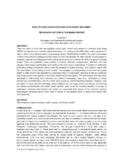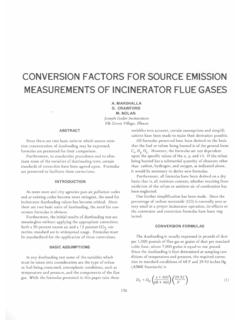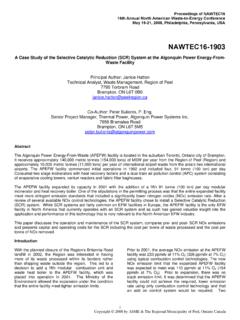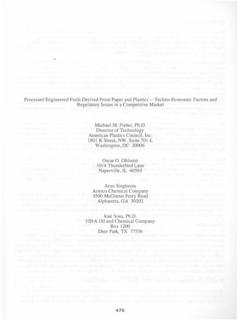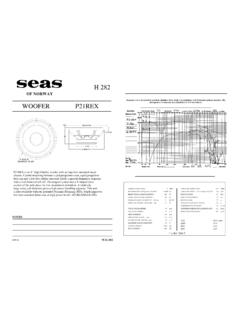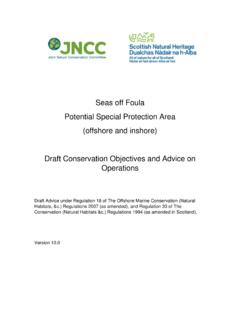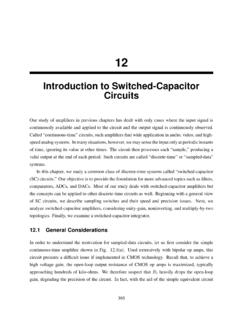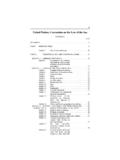Transcription of Recycling and reuse of resources – Rubber
1 Recycling Rubber Introduction Rubber is produced from natural or synthetic sources. natural Rubber is obtained from the milky white fluid called latex, found in many plants; synthetic rubbers are produced from unsaturated hydrocarbons. Long before Colombus arrived in the Americas, the native South Americans were using Rubber to produce a number of water-resistant products. The Spaniards tried in vain to copy these products (shoes, coats and capes), and it was not until the 18th century that European scientists and manufacturers began to use Rubber successfully on a commercial basis.
2 The British inventor and chemist Charles Macintosh, in 1823, established a plant in Glasgow for the manufacture of waterproof cloth and the rainproof garments with which his name has become synonymous. A major breakthrough came in the mid 19th century with the development of the process of vulcanisation. This process gives increased strength, elasticity, and resistance to changes in temperature. It also renders Rubber impermeable to gases and resistant to heat, electricity, chemical action and abrasion. Vulcanised Rubber also exhibits frictional properties highly desired for pneumatic tyre application.
3 Crude latex Rubber has few uses. The major uses for vulcanised Rubber are for vehicle tyres and conveyor belts, shock absorbers and anti-vibration mountings, pipes and hoses. It also serves some other specialist applications such as in pump housings and pipes for handling of abrasive sludges, power transmission belting, diving gear, water lubricated bearings, etc. In this brief, we will be looking primarily at the reclamation and reuse of scrap tyres. This is simply due to the fact that this is the major source of waste Rubber in developing countries. What is Rubber ?
4 natural Rubber is extracted from Rubber producing plants, most notably the tree Hevea brasiliensis, which originates from South America. Nowadays, more than 90% of all natural Rubber comes from these trees in the Rubber plantations of Indonesia, the Malay Peninsula and Sri Lanka. The common name for this type of Rubber is Para Rubber . The Rubber is extracted from the trees in the form of latex. The tree is tapped ; that is, a diagonal incision is made in the bark of the tree and as the latex exudes from the cut it is collected in a small cup. The average annual yield is approximately 2 kg per tree or 450kg per hectare, although special high-yield trees can yield as much as 3000kg per hectare each year.
5 The gathered latex is strained, diluted with water, and treated with acid to cause the suspended Rubber particles within the latex to coagulate. After being pressed between rollers to form thin sheets, the Rubber is air (or smoke) dried and is then ready for shipment. Synthetic Rubber There are several synthetic rubbers in production. These are produced in a similar way to plastics, by a chemical process known as polymerisation. They include neoprene, Buna rubbers, and butyl Rubber . Synthetic rubbers have usually been developed with specific properties for specialist applications.
6 The synthetic rubbers commonly used for tyre manufacture are styrene-butadiene Rubber and butadiene Rubber (both members of the Buna family). Butyl Rubber , since it is gas-impermeable, is commonly used for inner tubes. Table 1 below shows typical applications of various types of Rubber . Recycling of Rubber Practical Action Type of Rubber Application natural Rubber Commercial vehicles such as lorries, buses and trailers. Styrene-butadiene Rubber (SBR) and Butadiene Rubber (BR) Small lorries, private cars, motorbikes and bicycles. Butyl Rubber (IIR) Inner tubes.
7 Table 1: Applications of different classes of Rubber in the manufacture of vehicle tyres. The raw materials that make up tyres are natural and synthetic rubbers, carbon, nylon or polyester cord, sulphur, resins and oil. During the tyre making process, these are virtually vulcanised into one compound that is not easily broken down. Production of Rubber products The modern process of Rubber manufacture involves a sophisticated series of processes such as mastication, mixing, shaping, moulding and vulcanisation. Various additives are included during the mixing process to give desired characteristics to the finished product.
8 They include: Polymers Vulcanisation accelerators Activators Vulcanisation agents Fillers (carbon black) Fire retardants Anti-degradants Colorants or pigments Plasticisers Softeners Fillers are used to stiffen or strengthen Rubber .
9 Carbon black is an anti-abrasive and is commonly used in tyre production. Pigments include zinc oxide, lithopone, and a number of organic dyes. Softeners, which are necessary when the mix is too stiff for proper incorporation of the various ingredients, usually consist of petroleum products, such as oils or waxes; pine tar; or fatty acids. The moulding of the compound is carried out once the desired mix has been achieved and vulcanisation is often carried out on the moulded product. Vulcanisation To understand the process of vulcanisation it is worth discussing, briefly, the molecular structure of Rubber .
10 Crude latex is made up of a large number of very long, flexible, molecular chains. If these chains are linked together to prevent the molecules moving apart, then the Rubber takes on its characteristic elastic quality. This linking process is carried out by heating the latex with sulphur (other vulcanising agents such as selenium and tellurium are occasionally used but sulphur is the most common). There are two common vulcanising processes. Pressure vulcanisation. This process involves heating the Rubber with sulphur under pressure at a temperature of 150oC.
